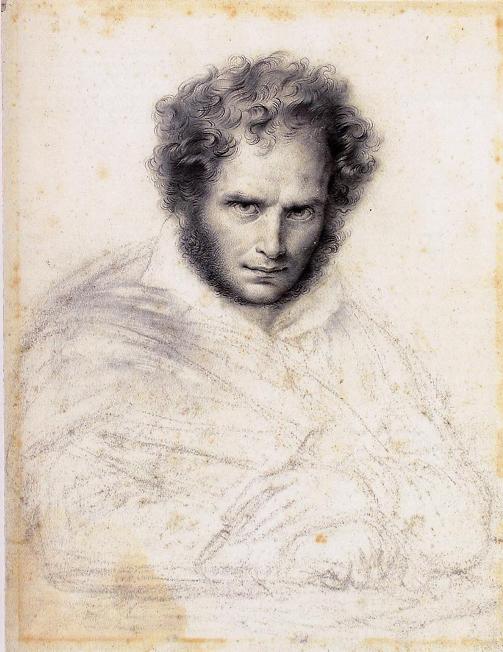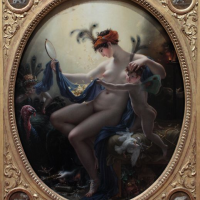Anne Louis Girodet
Anne Louis Girodet
Anne Louis Girodet (1767-1824)
Anne-Louis Girodet de Roussy-Trioson (or de Roucy), also known as Anne-Louis Girodet-Trioson (29 January 1767 – 9 December 1824), was a French painter and pupil of Jacques-Louis David, who participated in the early Romantic movement by including elements of eroticism in his paintings. Girodet is remembered for his precise and clear style and for his paintings of members of the Napoleonic family.

Girodet was born at Montargis. He lost his parents in his early youth. The care of his inheritance and education fell to his guardian, M. Trioson, "médecin-de-mesdames", who later adopted him. Girodet took the surname Trioson in 1812. In school he first studied architecture and pursued a military career. He changed to the study of painting under a teacher named Luquin and then entered the school of Jacques-Louis David. At the age of 22 he successfully competed for the Prix de Rome with a painting of the Story of Joseph and his Brethren. From 1789 to 1793 he lived in Italy and while in Rome he painted his Hippocrate refusant les presents d'Artaxerxes and Endymion-dormant (now in the Louvre), a work which was praised at the Salon of 1793.
Back in France, Girodet painted many portraits, including some of members of the Bonaparte family. In 1806, in competition with the Sabines of David, he exhibited his Scène de déluge (Louvre), which was awarded the decennial prize. In 1808 he produced the Reddition de Vienne and Atala au tombeau, a work which won immense popularity, by its fortunate choice of subject – François-René de Chateaubriand's novel Atala, first published in 1801 – and its remarkable departure from the theatricality of Girodet's usual manner. He would return to his theatrical style in La Révolte du Caire (1810).
Girodet was a member of the Academy of Painting and of the Institut de France, a knight of the Order of Saint Michael, and officer of the Legion of Honour. In his forties his powers began to fail, and his habit of working at night and other excesses weakened his constitution. In the Salon of 1812 he exhibited only a Tête de Vierge; in 1819 Pygmalion et Galatée showed a further decline of strength. In 1824, the year in which he produced his portraits of Cathelineauand Bonchamps, Girodet died on December 9 in Paris. At a sale of his effects after his death, some of his drawings realized enormous prices.
Girodet produced a vast quantity of illustrations, amongst which may be cited those for the Didot editions of the works of Virgil (1798) and Racine (1801–1805). Fifty-four of his designs for the works of he ancient Greek poet Anacreon were engraved by M. Châtillon. Girodet used much of his time on literary composition. His poem Le Peintre (rather a string of commonplaces), together with poor imitations of classical poets, and essays on Le Génie and La Grâce, were published posthumously in 1829, with a biographical notice by his friend Coupin de la Couperie. Delecluze, in his Louis David et son temps, has also a brief life of Girodet.
Girodet: Romantic Rebel at the Art Institute of Chicago (2006) was the first retrospective in the United States devoted to the works of Anne-Louis Girodet de Roussy-Trioson. The exhibition assembled more than 100 seminal works (about 60 paintings and 40 drawings) that demonstrated the artist's range as a painter as well as a draftsman.
The peculiarities which mark Girodet's position as the herald of the romantic movement are already evident in his Sleep of Endymion (1791, also called Effet de lune or "effect of the Moon"). He has a decided inclination to the ancient style, and a statuary expression is very perceptible in his works, but they are also distinguished for life, nature and beauty. His drawing is correct, and of great precision; his colouring is rich, transparent and harmonious. He works with equal care and genius. He loves to produce effect by strong lights which are nevertheless mostly in unison with the spirit of the pieces.
The same incongruity of classic and romantic elements marks Girodet's Danae (1799) and his Quatre Saisons, executed for the king of Spain (repeated for Compiègne), and shows itself to a ludicrous extent in his Fingal (Leuchtenberg collection, St. Petersburg), executed for Napoleon in 1802. This work unites the defects of the classic and romantic schools, for Girodet's imagination ardently and exclusively pursued the ideas excited by the varied reading of both classic and modern literature, and the impressions he received from the external world afforded him little stimulus or check; he consequently retained the mannerisms of his master's practice whilst rejecting all restraint on choice of subject.




